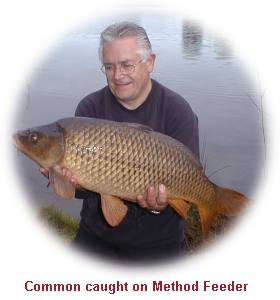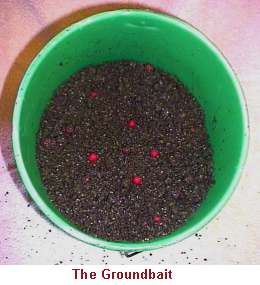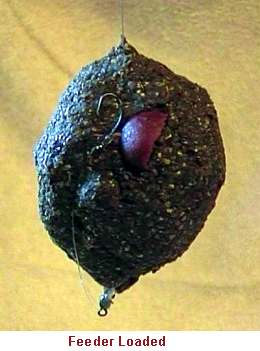Big Rik Belenger is better known as ‘Carp Angler’ on the FISHINGmagic Forum, where he is appreciated for his generous help to all and sundry. He has now extended that help with a regular carp fishing column for FISHINGmagic ‘The Carp Column’.
About Rik
Rik started fishing at the age of four on his local tiny tidal river, catching eels and small wild trout on worm. 
Not having had any angling family members, all his early fishing was solitary and this seems to have carried through to the present.
Like most anglers nowadays, he has a full time job and a family, so his fishing time is limited, although he does, he tells us, have a very understanding wife.He currently lives in the depths of Hampshire, and so is within easy reach of some excellent venues.
He has in the past, and still does, fish for most species, although his greatest love is for carp fishing, which is how the majority of his time is spent.
He now finds himself more thrilled with overcoming the intricacies and problems associated with catching carp, rather than the actual weight of the fish he catches and the so-called glory that goes with it.
Groundbaiting for Carp
Quite a lot has previously been written about fishing with groundbait for carp and what I would like to detail here are the various methods I use on a variety of venues.
My groundbait approach on a water depends on a variety of issues; they are carp stock, other species stock, depth of water fished, fishing distance, water clarity and water temperature. All these points need to be considered before choosing the type, ingredients, amount, application and consistency of the groundbait. 
Most people fish a groundbait and method feeder on heavily stocked fisheries where small to medium carp predominate.
Most commercial method mixes with a reasonably high food value will suffice, but the mix needs to be very stiff as the carp need to actively compete for the food and a very stiff mix means that the carp need to really attack the ball of feed to break away any food from it. This will lead to the carp grabbing at any food items that come adrift, hopefully including the hookbait.
All of my method feeder fishing is performed with Richworth Inline Feeders and for this heavily stocked water I would employ a short stiff link of 4in to 6in with a size 8 or 10 hook, knotless-knotted with a smallish bait of either maize, corn, mini boilies, or a broken boilie piece on the hair. This bait would be included in my mix and would depend on any bans in place. Broken boilies being my favourite as they can withstand the voracious attentions of the carp without coming adrift.
The groundbait approach can be used on less well-stocked venues and this is one of my favourite and most often used techniques. I have used this to devastating effect on this type of fishery, mostly medium-sized gravel pits of varying depths, of between 10 and 40 acres. They generally have a reasonable head of carp between 100 and 200 fish, a minimal amount of single figure fish with a predominance of mid to upper doubles with a good sprinkling of 20lb plus carp. 
These pits tend to also house a large head of bream or tench, or both, and a wealth of silver fish.
My groundbait for this type of venue takes a little work. It is a 50/50 mix of scalded pellet and Hinders A mix groundbait. I use three different types of pellet in equal measures; these are 3mm Hi-betaine, 8mm trout pellet and 12mm flavoured fishmeal pellets.
Mix these together dry and then sprinkle the bait with hemp oil, pellet oil and molasses. Pour boiling water over the pellets until they are just covered. Then give them a vigorous stirring and leave them to cool.
Try to evenly mix the pellets and groundbait together.
When the head of bream and tench is not so large, or not so active, I may add some chopped boilies or tiger nuts to the mix, this being my favoured approach in winter. In summer and autumn I tend to introduce free boilies over the top of the groundbait. 
My initial introduction of groundbait will consist of at least ten balls and could be as many as thirty. These balls will vary in size dependent on the distance I am fishing, but all will be squeezed very hard.
Introduce orange-sized balls by hand up to 20 yards, peach sized via a Drennan Groundbait Catty up to 70 yards and orange-sized using a Cobra Groundbaiting Spoon for between 70 and 100 yards. When fishing further out I give the balls a quick skim over with wet hands to avoid them breaking up in mid air.
After the initial baiting recast the baited feeder every 15 to 20 minutes or whenever a fish is caught – whichever is sooner.
The loading of the feeder is quite important. I usually pack an initial load into the feeder very hard, then apply a second layer, which is applied less compactly. This looser second layer gives a good dispersal and spread of enticing feed, while the inner core stays put, retaining the snack/trap properties. 
Because of the added oils and hemp inherent in the mix, the area is attractive from deck to surface. Most carp will be attracted by their natural curiosity to investigate other feeding fish and any carp cruising over the area should be able to taste the leaking food signal.
Once the carp move in, they will push the other species out of the immediate area so accurate recasting is a must.
My rigs for this are either 4in to 6in stiff links or 6in Snakeskin with 1in of outer coating near the hook removed. The hook is usually a size 6 or 4 depending on whether I’m fishing tiger nuts, 14mm or 18mm boilies. Any strong, sharp pattern can be used.
I generally fish with slackish lines and by watching the line and rod tip determine whether there are fish in the area. Once I am sure that there are fish feeding over the bait, I usually look anywhere other than at the rods. The constant rod top movement and pulls drives me crazy so I wait for the line to roar off. 
After watching carp feed over hard groundbait these are my observations: all sizes of carp will pick up the groundbait ball and drop it again, while it’s in their mouth they seem to either suck or bite a lump out of it, eat any bits floating in front of them, and then grab the groundbait ball again.
Smaller carp will nip in and steal the ball that another carp has dropped, but this doesn’t tend to happen with the larger fish. This has the effect of the larger carp not having to snatch so recklessly at the bait.
When they feed on groundbait the carp dirty the water quite considerably, the released particles of the groundbait seem to excite the fish even further and I have lost sight of carp in 4ft of clear margin when they have been going for it.
Another thing to add is to look at how long a ball of groundbait lasts in the margins when the silver fish attack it. A peach sized ball will last between 10 and 20 minutes, which is frighteningly quick. Think of how decimated your bed of bait will be, and that’s not taking into account the tench or bream.
When we get onto more lightly stocked venues, that invariably contain larger carp, the tactics I use change, although the bait ingredients generally stay the same.
The biggest difference is the consistency of the groundbait I introduce. I don’t compact the balls so hard as there is a less aggressive, competitive tendency with larger carp. I will introduce between 5 and 10 balls of groundbait and only 5 to 10 boilies. 
I don’t fish with feeders on this type of venue, preferring my leadcore with pendant lead and Korda link clip arrangement. This is coupled with either a fluoro stiff link or a semi-stiff Snakeskin hooklength. This is dependent on the bottom I am fishing over and whether I am fishing with bottom baits or pop-ups.
On this type of venue accurate baiting is essential and I ideally like to keep my bait within a 3ft diameter circle. I have found that in an area where carp feed they have a preferred spot within that area that they regularly visit. In this type of situation the carp will eat all the food but not generally in one visit.
The initial visit will occasionally, but not always, involve eating any bait. They will taste the water, but will not drop down onto the food.
The carp will return, sometimes accompanied by another carp, and will drop down on the baited area. The carp then eats, swims off and then returns to eat some more. If accompanied, the second carp will wait until the first carp has finished and then it will drop down onto the food.
When I’ve been baiting an area and not fishing it, I’ve witnessed the carp seeming to go off and fetch other carp in a type of procession and providing you can keep the feed in the area between the carp visiting, I have seen up to twelve fish taking it in turns to feed. This was on a lake that contained only twenty carp. Sixty percent of the lake’s carp population feeding in your swim, it makes me excited just thinking back on it.
Groundbaiting for big carp is very seldom used by anglers and can be a different and devastating method at all times of the year.
Get on it before they all find out!










